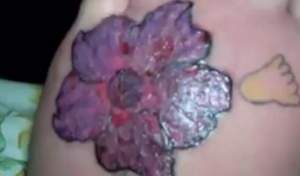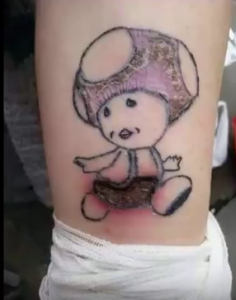Tattoo infection can occur due to varied causes. The most common causes, symptoms, and treatment options of tattoo infection are mentioned below.
Symptoms or signs of tattoo infection
A new tattoo will usually cause itchiness, pain, redness, and mild swelling for a day at the most. If the itching and swelling persist, or if the symptoms deteriorate, then it may be indicative of tattoo infection. Sometimes, the deep inner layers of skin may be infected. In such cases, the symptoms are delayed and tend to appear a few days after the new tattoo.
Common signs and symptoms of tattoo infection are as follows:
- The skin gets punctured during tattooing. Hence there is mild inflammation and redness. Spread of the inflammation and swelling outside the normal boundaries of the tattoo or worsening of redness, itching, tingling sensations, and prickly sensations, etc. may signal tattoo infection.
- One of the surest signs of tattoo infection is greenish or yellow discharge from the tattooed skin area. There may be pus development and deeper infection of the skin. Bleeding and skin peeling may also be a sign of deeper infection.
- The body temperature may rise markedly above normal. Mild fever after a new tattoo is also regarded as a sign of tattoo infection. In addition to elevated body temperature, muscle pain and weakness may also occur.
- When the area with tattoo begins to smell bad or emits a stinky odor, then it is indicative of exacerbation of tattoo infection.
- The process of tattoo involves breaking the skin and hence pain does occur. However, pain is restricted to the tattoo area and tends to persist for just a few hours. Any increase in the intensity of pain, its duration, or its spread to nearby skin is indicative of tattoo infection.
- Tattoo infections trigger an immune system response that sends white blood cells to fight the inflammation and infection. Subsequently, lymph nodes may become swollen.
- Increased warmth or hotness of the tattoo area along with shooting pain means that the tattoo infection is severe.
- Red streaking of the skin adjacent to the tattoo is indicative of blood poisoning. In such cases, patients need emergency care as it can be life-threatening.
- Other tattoo infections signs include skin rash, scabbing of infected area, and formation of blisters, lumps, abscess, pimples, and/or granulomas at the tattoo site.
Causes of tattoo infection
A tattoo infection may occur due to below listed causes:
- If tattooist uses non-sterilized needles
- If tattooist uses contaminated or low quality ink for tattoo inking
- If the tattoo parlor is dirty and unhygienic
- If the tattooist has bad personal hygiene
- If aftercare measures are not followed by the individuals after getting a new tattoo
- Laser removal of a pre-existing tattoo can also trigger skin infection
Treatment of tattoo infection
It is advisable to consult a doctor for treatment of an infected tattoo, even though the tattooist is qualified to handle tattoo infections.
Discussed below are treatment options and self-care measures for quicker healing of tattoo infection:
- Clean the infected skin area, tap it completely dry, and then apply antibiotic ointment prescribed by the doctor. Repeat this process two times per day till there is complete recovery from tattoo infection.
- Keep the infected area open and do not apply any bandages. This will limit the further multiplication of bacteria and encourage healing.
- Doctors may sometimes cover the infected skin area. A sterile gauze with antibiotic cream or an antibiotic ointment may be applied on the infected tattoo area after it has been cleaned and tapped dry. Then bandage the area and change it regularly.
- Water worsens infection; hence avoid contact of infected area with water and ensure that it is kept dry at all times. Don’t swim and protect infected area from contact with water during showers/bath
- Avoid contact with harsh or scented soaps, petroleum skin products, or colored lotions. They cause skin irritation and impede recovery. Petroleum products are used for ensuring that the tattoo remains wet and warm; such conditions are best suited for bacteria to grow and thrive.
- Avoid contact with dirt, pets, grime, sweat, or other body fluids. Ensure that the infected tattoo does not touch clothes, bedding, etc.
- If above steps do not help heal the tattoo infection, then doctors may opt for oral antibiotics or an IV. Additional tests for verification of the bacteria strain, etc., may also be done. Patients need to finish the full dosage prescribed by doctor and not stop mid-way (if there is improvement of symptoms) as doing so can increase the chances of tattoo infection reoccurrence.
Follow the steps given below to prevent tattoo infection:
- Ensure that the tattooist is qualified and that branded, high quality non-contaminated ink and sterilized new needles are used for tattoo inking process
- Follow all tattoo aftercare instructions
- Don’t remove bandage on tattoo applied by tattooist for 2 to 4 hours. Then remove bandage, wash the area, and apply balm given by tattoo professional. Repeat it for 14 to 48 hours
- Stay in cool environments as heat can trigger infections.

